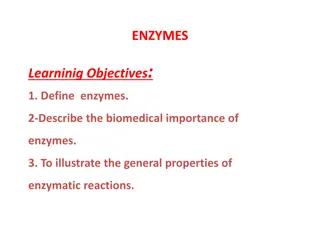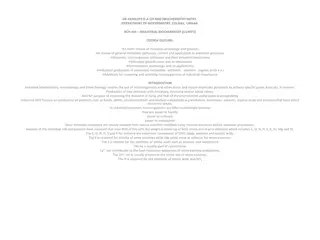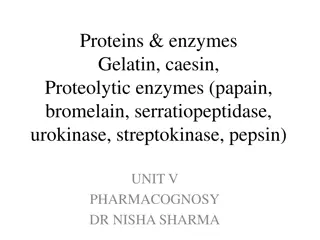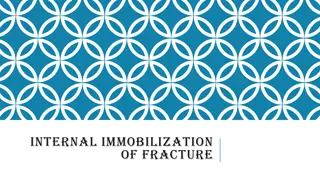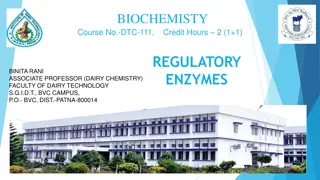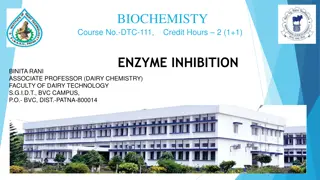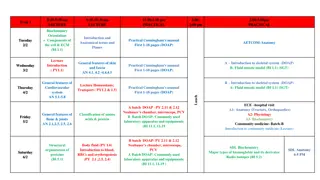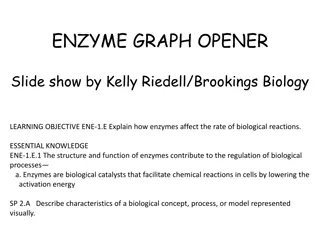Immobilization of Enzymes in Biochemistry
Enzyme immobilization involves confining enzyme molecules to a distinct phase from substrates and products, attaching them to solid matrices for enhanced specificity and reduced inhibition. Inert polymers or inorganic materials are used as carrier matrices with methods like physical adsorption onto an inert carrier, creating directly usable forms of enzymes by mixing with suitable adsorbents. The choice of adsorbent minimizes enzyme leakage during use, considering factors like strong physical links and substrate introduction.
Download Presentation

Please find below an Image/Link to download the presentation.
The content on the website is provided AS IS for your information and personal use only. It may not be sold, licensed, or shared on other websites without obtaining consent from the author.If you encounter any issues during the download, it is possible that the publisher has removed the file from their server.
You are allowed to download the files provided on this website for personal or commercial use, subject to the condition that they are used lawfully. All files are the property of their respective owners.
The content on the website is provided AS IS for your information and personal use only. It may not be sold, licensed, or shared on other websites without obtaining consent from the author.
E N D
Presentation Transcript
BIOCHEMISTY Course No.-DTC-111, Credit Hours 2 (1+1) IMMOBILIZATION OF ENZYMES BINITA RANI ASSOCIATE PROFESSOR (DAIRY CHEMISTRY) FACULTY OF DAIRY TECHNOLOGY S.G.I.D.T., BVC CAMPUS, P.O.- BVC, DIST.-PATNA-800014
Enzyme immobilization may be defined as => confining the enzyme molecules to => a distinct phase from the one in which => the substrates and the products are present. It is process of attachment of an enzyme to => a solid matrix so that => it cannot escape but => can still act on its substrate.
Materials The materials used for immobilization of enzymes, called => carrier matrices, are usually => inert polymers or inorganic materials. The ideal carrier matrix has the following properties: 1. Low cost, 2. Inertness, 3. Physical strength 4. Stability 5. Regenerability after the useful lifetime of the immobilized enzyme, 6. Enhancement of enzyme specificity, 7. Reduction in product inhibition, 8. A shift in the pH optimum for enzyme action to => desired value for the process, and reduction in microbial contamination and nonspecific adsorption
Methods used for the Immobilization of Enzymes 1.Physical adsorption onto an inert carrier Adsorption of enzymes onto insoluble supports is a very simple method of => wide applicability and capable of high enzyme loading (about one gram per gram of matrix).
Simply mixing the enzyme with a suitable adsorbent => under appropriate conditions of pH and ionic strength => followed after a sufficient incubation period => by washing off loosely bound and unbound enzyme will produce => immobilised enzyme in a directly usable form. The driving force causing this binding is usually due to => a combination of hydrophobic effects and the formation of several salt links per enzyme molecule.
The particular choice of adsorbent depends => principally upon minimizing leakage of enzyme during use. Although the physical links between the enzyme molecules and the support are => often very strong, they may be reduced by many factors => including the introduction of the substrate
Care must be taken that => binding forces are not weakened during use by inappropriate changes in => pH or ionic strength. Examples of suitable adsorbents are => ion- exchange matrices, porous carbon, clays, hydrous metal oxides, glasses and polymeric aromatic resins.
2.Covalent binding to a reactive insoluble support Only small amounts of enzymes may be immobilised by => covalent binding (about 0.02 gram per gram of matrix). The strength of binding is very strong, however, and very little leakage of enzyme from the support occurs. The relative usefulness of various groups, found in enzymes, for covalent link formation depends upon => their availability and reactivity (nucleophilicity) => in addition to the stability of the covalent link, once formed.
The reactivity of the protein side-chain nucleophiles is => determined by their state of protonation (i.e. charged status) and => roughly follows the relationship -S- > - SH > -O- > -NH2 > -COO- > -OH > NH3+ where => charges may be estimated from => knowledge of the pKa values of the ionising groups and the pH of the solution.
Lysine residues are found to be => the most generally useful groups for => covalent bonding of enzymes to insoluble supports due to => their widespread surface exposure and high reactivity => especially in slightly alkaline solutions. They also appear to be only very rarely involved in => active sites of enzymes.
Commonly used method for the covalent immobilization of enzymes
3.Inclusion in the lattices of a polymerized gel or entrapment or membrane confinement Entrapment of enzymes within gels or fibres is a convenient method for => use in processes involving low molecular weight substrates and products. Amounts in excess of 1 g of enzyme per gram of gel or fibre => may be entrapped. Large molecules have difficulty in => approaching the catalytic sites of entrapped enzymes precludes => use of entrapped enzymes with high molecular weight substrates.
The entrapment process may be a purely physical caging or involve covalent binding. As an example of this latter method => the enzymes' surface lysine residues may be derivatised by reaction with acryloyl chloride (CH2=CH-CO-Cl) => to give the acryloyl amides. This product may then be copolymerised and cross- linked with acrylamide (CH2=CH-CO-NH2) and bis acrylamide (H2NCO-CH=CH-CH=CH-CO-NH2) to form a gel.
Enzymes may be entrapped in cellulose acetate fibres by, for example => making up an emulsion of the enzyme plus cellulose acetate in methylene chloride => followed by extrusion through a spinneret into a solution of an aqueous precipitant.
Entrapment is the method of choice for the immobilisation of microbial, animal and plant cells => where calcium alginate is widely used. (a)enzyme non-covalently adsorbed to an insoluble particle; (b)enzyme covalently attached to an insoluble particle; (c)enzyme entrapped within an insoluble particle by a cross-linked polymer; (d)enzyme confined within a semipermeable membrane
Utility of Enzyme Immobilization Use of immobilized enzyme => eliminate enzyme separation step from the main process thus => simplifying and increasing the overall process yield. Easy separation from reaction mixture => providing the ability to control reaction times and minimize the enzymes lost in the product. Re-use of enzymes for many reaction cycles => lowering the total production cost of enzyme mediated reactions. Ability of enzymes to => replace multiple standard chemical steps and provide commercially pure products.
Properties of Immobilized Enzymes It is important to understand the changes in physical and chemical properties => which an enzyme would be expected to undergo upon insolubilization if => the best use is to be made of the various insolubilization techniques available. Changes have been observed in the stability of enzymes and in their kinetic properties => because of microenvironment imposed upon them by the supporting matrix and by the products of their own action.
Stability The stability of enzymes might be expected to either increase or decrease on insolubilization => depending on whether the carrier provides a microenvironment capable of denaturing the enzymic protein or of stabilizing it. Inactivation due to autodigestion of proteolytic enzymes should be reduced => by isolating the enzyme molecules from immobilizing them on a matrix. mutual attack by
It has been found that enzymes coupled to inorganic carriers were => generally more stable than those attached to organic polymers when stored at 4 or 23 C. Stability to denaturing agents may also be changed upon insolubilization. Kinetic properties Changes in activity of enzymes due to => actual process of insolubilization have not been studied in detail. There is usually a decrease in specific activity of an enzyme upon insolubilization => and this can be attributed to denaturation of the enzymic protein caused by the coupling process.
Once an enzyme has been insolubilized, however, => it finds itself in a microenvironment that may be drastically different from that existing in free solution. The new microenvironment may be => result of the physical and chemical character of the support matrix alone, or it may result from => interactions of the matrix with substrates or products involved in the enzymatic reaction.
The diffusion of substrate from the bulk solution to the micro-environment of an immobilized enzyme can limit => the rate of enzyme reaction. The rate at which substrate passes over the insoluble particle affects => thickness of the diffusion film => which in turn determines the concentration of substrate in the vicinity of the enzyme and hence the rate of reaction. The effect of the molecular weight of the substrate can also be large.
Diffusion of large molecules will obviously be limited by steric interactions with the matrix, and => this is reflected in the fact that => relative activity of bound enymes towards high molecular weight substrates has been generally found to be lower than towards low molecular weight substrates. This, however, may be an advantage in some cases => since the immobilized enzymes may be protected from attack by large inhibitor molecules.

 undefined
undefined








